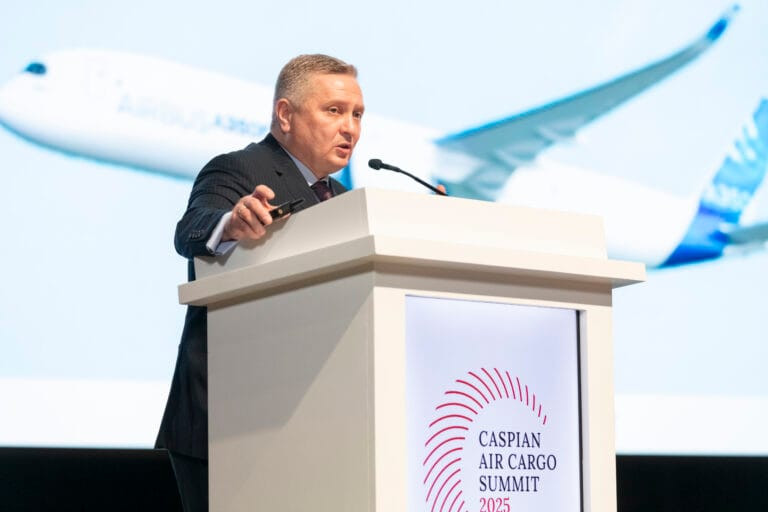- Silk Way West Airlines is pursuing a dual strategy: renewing its widebody freighter fleet and building a dedicated cargo airport in the Alat Free Economic Zone, a Greenfield project designed to integrate air, sea, rail, and road transport along the Middle Corridor to enhance regional and global connectivity.
- The Alat airport is being constructed with sustainability at its core, including green building materials, solar energy, electric ground equipment, water conservation, and biodiversity protection, alongside low-noise operations and incentives for eco-friendly partners, aiming to become a benchmark for sustainable aviation in the region.
- Advanced digitalisation and automation will underpin operations, with a 30,000 sq m terminal featuring ASRS, state-of-the-art airfield lighting, and real-time data integration across the supply chain, designed to increase efficiency, transparency, and capacity from 500,000 tonnes today to 1.2–1.5 million tonnes annually in the coming years.
“The two big strategic pillars we are building our future upon are the fleet renewal of Silk Way West Airlines and the construction of our own cargo airport in the Alat Free Economic Zone,” Wolfgang Meier, President and CEO of Silk Way West Airlines, declared at the Caspian Air Cargo Summit in Baku. “Those are the foundations of our future strategy.”
That blunt assessment captures both the scale of Azerbaijan’s ambition and the stakes involved in the new Alat airport project. Positioned on the Caspian shore, 70 kilometres south of Baku, the airport is the centrepiece of a free economic zone designed to connect air, sea, road and rail freight along the so-called Middle Corridor. Unlike the incremental expansions seen at established hubs, Alat is a Greenfield project that aspires to redefine how a mid-sized country positions itself in the global cargo market.
A strategic leap for Silk Way West Airlines
Silk Way West Airlines has grown into one of the region’s leading freighter operators with a fleet of over two dozen widebody aircraft. Its next phase, Meier argues, requires infrastructure of its own.
“We started this fleet renewal four years ago,” he said. “At the same time, the second strategic pillar is the construction of our own cargo airport in the Alat Free Economic Zone. Those are the two main pillars we are building our future upon.”
Why Baku? Geography, above all. “Baku connects the global markets with the local and regional markets,” Meier explained. “It’s this mixture of connectivities which makes it a very attractive place to be. Entry barriers for doing business here are very low. It’s a perfect place to do logistics.”
The Alat site is designed to capitalise on that. Its central opportunity lies in multimodality. “The biggest opportunity I see is the multimodal offering facilitated through the new airport,” Meier added. “We are going to connect air freight with railway and overland transport along the Middle Corridor. That will enhance the logistics offering through the new airport.”
This strategy also reflects the limits of existing infrastructure. Heydar Aliyev International Airport, Baku’s current gateway, has been under pressure from both passenger and cargo growth. A new dedicated cargo airport, directly integrated with a free zone, is seen as the logical next step.
Building a new hub from scratch
Jawad Dbila, CEO of Silk Way AFEZCO, frames the decision in straightforward terms. “It was very wise to take such a decision to have our own airport, because so far Silk Way West Airlines is among the biggest cargo airlines in the region,” he told ACW. “The idea came just three years ago. We decided the best place is the Alat Free Economic Zone, because first of the location, second, it’s a multimodal free zone. There’s a seaport, a train station — in the middle between north, south, east, west. The only missing piece was the airport.”
Construction began in April 2024, with completion scheduled for late 2026 or early 2027. The scale is notable. A 4,000-metre-long, 75-metre-wide runway is being laid, with 18 Code F parking stands. A 30,000 sq m cargo terminal is underway, in joint venture with dnata, which will handle ground services, catering and operations.
“We are building the biggest cargo terminal in the region,” Dbila said.
The project is not limited to freight. “We will also build business aviation facilities,” he noted, pointing to Silk Way West Airlines’ purchase of new Gulfstream aircraft and a joint venture with Luxair to operate them. “In the future, we are thinking to build a passenger terminal, ready in 2029. It will be complementary to Heydar Aliyev airport, because there are destinations they don’t fly to. We will not compete with them but offer more options for Azerbaijani and foreign passengers.”
This dual strategy reflects pressure on the capital’s existing airport. Azerbaijan’s tourism sector is expanding, fuelled by events such as Formula 1 and winter tourism in Shahdag. “As in any capital, you need at least two airports,” Dbila argued.
Sustainability as a test case
If Alat is to make its mark, sustainability will be central. Dbila calls it a “green airport” project, with sustainability designed in from the outset. “Every flight begins at the airport… two miles of road takes you nowhere, but two miles of runway takes you everywhere,” he said at the Caspian Air Cargo Summit 2025. “That is why we decided to construct a new green airport in our area.”
The challenge, he admits, is that there are no unified international standards for sustainable airports. ICAO offers guidelines on airline emissions, but little on airport operations. “Airport operations cover approximately three percent of pollution. Aircraft operations — landing, take-off, taxiing — consume 57 percent, and road transport 40 percent,” he said, citing a study of 400 airports. “We, as airport operators, can reduce only 3 percent, but we must prepare the field for airlines to reduce their 57 percent.”
The roadmap involves six steps: policy establishment, planning green infrastructure, sustainable construction methods, procurement of low-emission ground equipment, operational standards on waste management and biodiversity, and incentives for eco-friendly partners.
Construction choices reflect this. Green building materials, low-energy lighting, water conservation and biodiversity protection are all built into the design. Solar generation is planned: Azerbaijan’s solar potential is 50 percent higher per square metre than the European average. Most ground equipment will run on electric power; minimal diesel units will be replaced with biodiesel.
Noise is another consideration. The airport is located 6.5 km from Alat (12,700 residents) and 26 km from Salyan (881 residents). “We think the noise contour will not exceed 60 decibels at the edge of the city,” Dbila said.
The goal, he stresses, is not abstract. “Alat airport should be the benchmark for sustainable operations in the region. We will continue cooperation with ICAO and stakeholders for continuous improvement and long-term commitment to environmental stewardship.”
Alat’s place on the map
Lars-Gunnar Comén, Director of Euroavia International and Organiser of the Caspian Air Cargo Summit, offers an outside view.
“I believe it will be unique. How many airlines build their own airports? Not many. Maybe initially I wondered why they do this. But now, when I see the development and how Azerbaijan and Silk Way West Airlines are growing, I think this is exactly the right time. It’s a great opportunity,” he said.
For Comén, the impact goes beyond Silk Way West Airlines. “When you create such a strong base and build up such a strong hub, it automatically puts the country in a stronger position. It creates jobs, opportunities and development for the whole logistics sector, not only Silk Way West Airlines.”
Today, Silk Way West Airlines handles over 500,000 tonnes annually. Dbila sets ambitious targets. “In the next three or four years, we will raise that to 1.2 to 1.5 million tonnes per year,” he said.
The driver is Alat Free Economic Zone. “Ninety-five percent of our cargo has been transit. Only 5 percent originates in Azerbaijan. With the free zone, we hope to increase that to 40–50 percent,” Jawad Dbila explained. New residents – from light industry to pharma and perishables – are expected to generate substantial flows.
Digitalisation and the operational layer
Technology partners are already being lined up. Dnata, the cargo handling specialist, will run the 30,000 sq m terminal. Automation will be central. “Our cargo terminal will be more advanced than dnata’s new Amsterdam terminal,” Dbila claimed. “We are using the latest technology from Lödige. We will have a fully automated system – ASRS – at the cargo terminal.”
Another innovation is in airfield lighting. “We will be the first airport in the world to use the latest AGL technology,” he said. “It’s low energy, cable-based, and provides all the data about each lamp and substation. It’s cheap, efficient and supports our aim of being the first green airport in Azerbaijan.”
For Bernhard Kindelbacher, CEO of ACL Airshop, which supplies ULD Management solutions to Silk Way West Airlines, the opportunity lies in digitalisation of equipment flows. “We will support them to make sure their hub is as efficient and digital as possible,” he told ACW. “Airlines and handlers can use this data to make processes more efficient, faster, and serve customers better.”
He is clear about the industry’s shortcomings. “We still use a lot of manual processes, but not enough real-time actions. Sharing data across the chain would increase efficiency in each process, while giving transparency and ideas to the next partner,” Kindelbacher said.
Between promise and proof
Alat’s ambition is vast. Runways and warehouses are easy to measure, but the test will be whether the new hub can deliver the connectivity, efficiency and sustainability its backers promise. There are geopolitical risks. The Middle Corridor is shaped by shifting trade flows away from Russia, with all the uncertainty that entails.
Yet for Azerbaijan, the logic is clear. Control of its own infrastructure gives it leverage over its role in global trade. “Every flight begins at the airport,” Dbila said.





